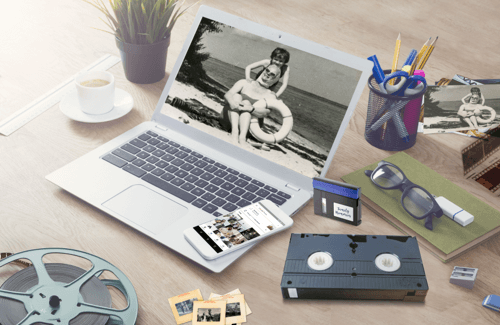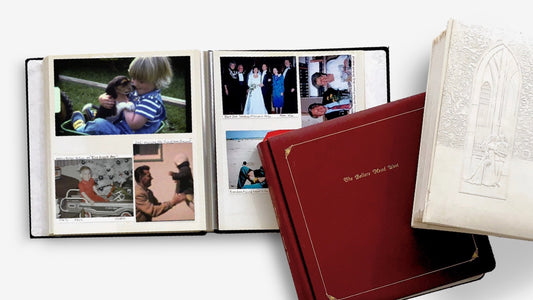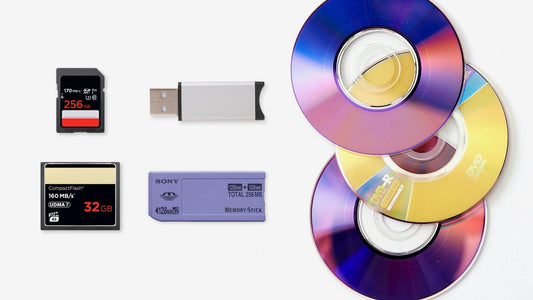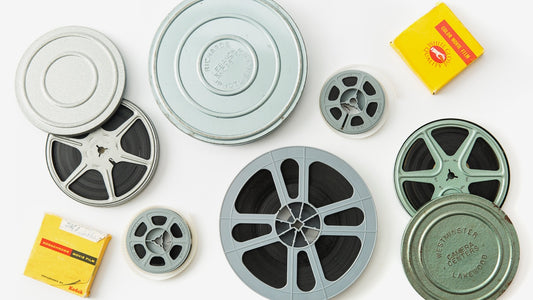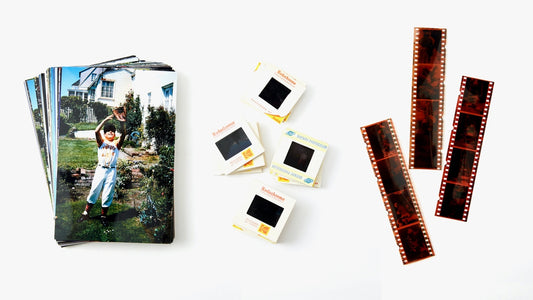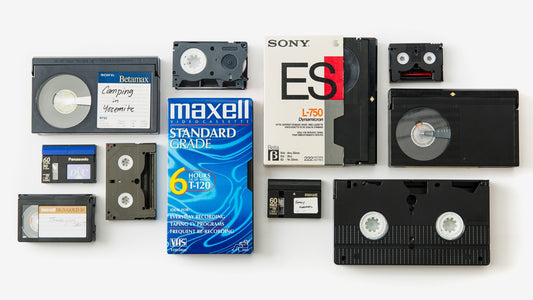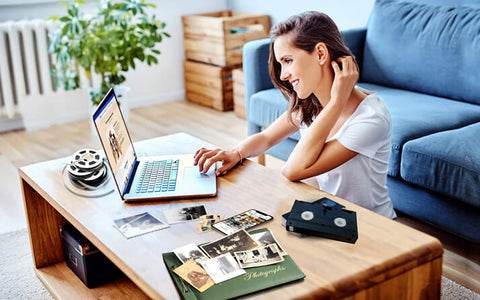Home movies hold a special magic. Those flickering images on 8mm film contain a treasure trove of your family history, from birthdays to everyday moments that shaped your life. But 8mm film is fragile. Time, humidity, and dust can fade the colors and degrade the film, putting those precious memories at risk of being lost forever. That's why it's so important to digitize 8mm film. It creates a lasting, shareable archive for generations to come. This guide offers practical advice on the why, how, and where of digitization, so you can preserve your family’s legacy.
Key Takeaways
- Preserve your memories by digitizing 8mm film: 8mm film degrades over time. Digitizing it ensures your precious home movies are safe from damage and deterioration. Consider professional services or DIY methods depending on your needs and resources.
- Focus on quality and ease of use: Resolution, file formats, and extra features like color correction significantly impact the final product. Choose a digitization method that balances quality with a straightforward process.
- Protect and share your digitized memories: Securely store your digital files using external hard drives or cloud storage, and back them up regularly. Share your digitized films with family and friends through DVDs, flash drives, or online platforms.
What is 8mm Film and Why Should You Digitize It?
8mm film is a motion picture film format popular for home movies from the 1930s to the 1980s. Its compact size and ease of use made it a favorite for capturing family memories. Unfortunately, like all physical film, 8mm degrades over time. Those precious memories captured on 8mm film are vulnerable to fading, scratches, and even complete loss if not properly preserved.
That's why converting your 8mm movies to digital is so important. Digitizing your films safeguards your family history by creating a permanent, high-quality copy. Unlike physical film, which deteriorates, a digital copy can be stored indefinitely without any loss of quality and offers easy access for sharing. Imagine instantly sharing those special moments with family and friends, ensuring those memories are enjoyed for generations to come.
Digitizing also opens up new possibilities. You can easily edit your 8mm footage, removing unwanted sections or adding music and titles. Plus, digital files are much simpler to store and manage than bulky film reels. Explore options for converting 8mm tapes. It's a practical way to preserve your memories using today's technology.
A Brief History of Home Movies
The Rise of 8mm and Super 8 Film
For decades, from the 1930s all the way through the 1980s, 8mm film was the go-to format for families wanting to capture their lives in motion. Its compact size and user-friendly cameras made it possible for everyday people, not just Hollywood directors, to create home movies. This was later followed by Super 8 film, which offered an even larger image area and simpler cartridge loading. These formats are likely what your parents or grandparents used to document everything from your first steps to family vacations. They are the reason we have these beautiful, candid glimpses into the past, full of authentic moments and unscripted laughter. Understanding this history helps us appreciate the delicate, irreplaceable nature of these film reels.
Top Reasons to Digitize Your Film Collection
Your Old Projector Probably Doesn't Work
Even if you’ve managed to hold onto the family’s old film projector, there’s a good chance it no longer works. These machines have countless moving parts that can fail over time, and finding someone to repair them is nearly impossible. Worse, a malfunctioning projector can easily snag, tear, or even burn your fragile film, destroying it forever. The reality is that for most of us, those film reels are unwatchable without some help. The most reliable way to see those memories again is through professional film transfer. By converting your reels to a digital format, you not only preserve them from physical decay but also make them instantly accessible, so you can watch and share them without needing any outdated equipment.
Your Options for Digitizing 8mm Film
You’ve got two main paths for digitizing those 8mm films: hiring a pro or doing it yourself (DIY). Both have their own pros and cons, so let's explore to see which best fits your needs.
Letting the Pros Handle It
Professional services bring expertise and specialized equipment to the table, delivering high-quality digital transfers. Companies like YesVideo handle a variety of formats, including 8mm film, and manage the entire process. This hands-off approach is perfect if you're short on time or prefer to leave it to the experts. Services like Legacybox are also a popular choice for their simple process. While professional digitization typically costs more, it often includes perks like quality assurance, color correction, and other enhancements to make your memories shine.
Doing It Yourself: The DIY Method
If you're comfortable with technology and enjoy hands-on projects, DIY conversion can be a rewarding experience. This method puts you in the driver's seat. Converting your films yourself can be easier on the wallet than professional services, especially if you already own some of the equipment, like a modern camera or projector. Resources like Shotkit offer helpful guides on using cameras for this purpose. However, DIY requires a time investment, and the quality depends on your equipment and skills. You might run into issues like noise and grain, especially with lower-quality equipment, as noted by the California Learning Resource Network. But with careful planning and execution, DIY can be a great way to preserve your 8mm films on a budget.
What to Look For When Digitizing 8mm Film
When converting those precious 8mm films to digital, consider a few key features to ensure the best possible results. Think of it as choosing the right ingredients for a cherished family recipe—each element contributes to the final outcome.
Focusing on Resolution & Quality
Resolution and quality are paramount. You want your digital memories to be as vibrant and clear as possible. Choosing a reputable company like YesVideo for your 8mm film transfer ensures a professional, high-quality conversion that maintains the integrity of your original films. Look for services offering high-resolution scanning, ideally at or above 1080p, to capture every detail and preserve the original film's color and clarity. Professional services often have the equipment and expertise to handle delicate film and produce superior results, as Capture explains in their guide to digitizing.
Is 2K Resolution Worth It for Home Movies?
You might see options for 2K resolution and wonder if it’s a necessary upgrade. While 1080p HD provides excellent clarity for most home movies, 2K scanning captures even more fine detail from the original 8mm film. Think of it as the difference between a great photo and a stunningly sharp one. For films that are especially precious or have a lot of visual texture, 2K can make a noticeable difference, preserving subtle nuances that bring your memories to life. Professional services often provide much better quality results than DIY methods, and opting for a higher resolution scan is one way they achieve this. Ultimately, it’s a personal choice, but for irreplaceable footage, investing in 2K ensures you’re getting the most detailed and vibrant digital copy possible.
Making Sure It's Easy and Compatible
Digitizing old films shouldn't be complicated. Look for services or DIY methods that offer a straightforward experience. YesVideo, for example, provides a simple ordering process, making it easy to send in your films and receive your digital copies. User-friendly services like Legacybox are popular for their accessibility, as highlighted in Video Conversion Experts' review of 8mm film transfer services. Consider factors like shipping, handling, and the overall process.
Choosing the Right File Format
Think about what you want to do with your digitized films. Do you want to watch them on your computer, TV, or share them online? Understanding the different file formats available is important. Services like YesVideo typically offer several options, including DVDs and digital downloads. Choosing the right format ensures easy access to your memories. A service like Envision Video Services can help you understand more about file formats.
Don't Forget the Extra Features
Finally, consider any extra features that might enhance your digitized films. Some services offer extras like color correction, audio enhancement, or even highlight reels. While YesVideo focuses on core digitization services, others like iMemories provide a wider range of options, including cloud storage and various physical media formats, as noted in this comparison. These extra features can add value and make your digital memories even more special. Focal Crafters discusses additional features like flicker reduction and noise removal, which can significantly improve the final quality of your videos, in their 8mm digitization guide.
How to Choose a Professional Service
Handing over your family's irreplaceable films can feel like a big step, but choosing the right professional service makes all the difference. A great company will not only deliver a high-quality digital product but also give you peace of mind throughout the process. The key is knowing what to look for and which questions to ask. Think of it as hiring a trusted caretaker for your memories. You want someone with experience, the right tools, and a genuine respect for the precious cargo you're entrusting to them. Let's walk through how to identify a service that will treat your films with the care they deserve.
Key Questions to Ask Before You Commit
Before you send your films anywhere, it’s wise to do a little homework. A reputable company will be transparent and happy to answer your questions. Start by looking for a service that specializes in film conversion and has a long history of positive reviews. Ask how long they've been in business—experience matters when handling delicate, aging film. For instance, YesVideo has been helping families preserve memories for over 20 years. Also, make sure their pricing is clear, with no hidden fees for setup or file types. Finally, get an estimate on the turnaround time so you know when to expect your precious memories back, safe and sound in their new digital format.
Features That Signal a Top-Tier Service
Not all digitization services are created equal. To ensure you get a beautiful final product, look for features that indicate a commitment to quality. High-resolution scanning, at 1080p or higher, is essential for capturing the crisp details and vibrant colors of your original films. A top-tier service will also handle your reels by hand, which minimizes the risk of damage that automated machinery can cause. At YesVideo, every order is processed by hand in the USA, ensuring each frame is treated with care. This hands-on approach helps maintain the integrity of your original films while producing a superior digital transfer.
Advanced Options for Damaged Film
If your films are showing their age with scratches or brittleness, don't lose hope. Some professional services offer advanced restoration options that can work wonders. When you inquire, ask if they provide "wet gate scanning." This specialized process can dramatically reduce the appearance of scratches and abrasions by applying a fluid to the film during scanning, resulting in a much cleaner and clearer picture. It's a fantastic option for well-loved films that have seen a lot of use. For those who want the ultimate in long-term preservation, you can also ask if a service can save your footage onto LTO data tapes, a professional-grade format designed for archival storage.
Should You Hire a Pro or Do It Yourself?
When deciding how to convert your 8mm films to digital, you’ll likely weigh professional services against DIY methods. Both have their pros and cons, so let's break down each option to help you make the best choice for your treasured memories.
The Difference in Quality and Expertise
Professional services like YesVideo specialize in film handling and high-quality transfers. They use professional equipment and techniques to produce the best possible digital copies, addressing issues like flicker, color correction, and sound optimization. Experts can handle various film formats, including 8mm and Super 8, ensuring compatibility and a smooth process. If you prioritize the highest resolution and best preservation, professional digitization maintains the integrity of your memories. DIY methods, while more affordable, may sacrifice some quality, especially if you're unfamiliar with the technical aspects of film transfer. As Capture points out, if basic digital copies are sufficient, a DIY approach might work.
Why Professional Scanners Make a Difference
The quality of the scanner plays a huge role in the final result. The equipment used by professional services is worlds apart from what you might find for at-home use. These high-end scanners are specifically designed to handle delicate, aging 8mm film, capturing it frame-by-frame to produce a smooth, flicker-free video. This process ensures you get a high-resolution digital file, typically 1080p or higher, which preserves the original color and clarity of your home movies. When you opt for a professional service, you're paying for access to this specialized technology that delivers high-quality digital transfers. It’s the difference between a fuzzy, shaky video and a crisp, stable one that truly does justice to your memories.
The Importance of a Skilled Technician
Even the best scanner is only as good as the person operating it. This is where a skilled technician becomes invaluable. Over the years, film can become brittle, dirty, or even damaged. A trained professional knows how to inspect, clean, and repair your film before it ever touches a scanner, ensuring the safest and highest-quality transfer possible. At YesVideo, our technicians handle every order by hand, bringing years of experience to the process. They can manually adjust for issues like poor exposure or color shifts, making sure your final video looks its best. This human touch and expertise in film handling is something a DIY setup simply can't replicate, providing peace of mind that your irreplaceable memories are in good hands.
How Much Time and Effort Is Involved?
Digitizing 8mm film yourself can be time-consuming. It requires acquiring equipment, learning the process, and dedicating time to the transfer and editing. A large film collection can make this a significant project. Professional services handle everything for you, from shipping to the final digital files. Walmart Film Transfer estimates the process takes 3–4 weeks. This frees up your time so you can enjoy your memories once they're digitized.
Gauging the Size of Your Project
Before you decide, take a quick inventory of your film collection. Do you have a handful of reels or a box full of them? A small project with just a few films might feel like a fun weekend DIY task. However, if you're looking at a substantial collection, the time commitment for a DIY approach can quickly add up. Each reel needs to be individually scanned and edited, which can turn into a significant undertaking. For larger collections, a professional film transfer service simplifies the process entirely. You just send in your films, and they handle the meticulous work, saving you countless hours and ensuring a consistent, high-quality result for your entire family archive.
Breaking Down the Costs
DIY conversion initially seems cheaper. However, costs can accumulate when factoring in equipment, software, and potential troubleshooting. Legacybox starter kits cost around $70 for just a couple of items. Professional services offer various pricing tiers based on film length, quality, and added features. Walmart's basic film transfer starts at $12.96 for the first 50 feet. Consider the long-term value of professional expertise and the time saved when evaluating the overall cost.
Who Handles the Troubleshooting?
DIY digitization can present technical challenges. Focal Crafters highlights common issues like flicker, noise reduction, and aspect ratio conversion. Troubleshooting these requires technical knowledge and can be frustrating. Professional services have the expertise to handle these issues, ensuring a smooth experience. Shipping irreplaceable media is a valid concern. Zoopy acknowledges worries about potential loss or damage during shipping. Professional services offer secure shipping and handling, providing peace of mind.
How Much Does 8mm Digitization Cost?
Digitizing your 8mm films is an investment in preserving precious memories. But how much should you expect to spend? The answer depends on whether you choose a professional service or the DIY route.
How Professional Services Charge
Professional 8mm film digitization services offer convenience and expertise. Companies like YesVideo handle everything for you, from carefully handling your films to producing high-quality digital files. Pricing varies based on several factors, including the length of your films and any additional services. Some companies offer tiered packages based on the amount of film you need converted, similar to Legacybox's options, which range from smaller "Starter Kits" to larger "Trunk Kits." You'll also find services like those available from Walmart, which digitize various film formats, often charging a base fee for an initial amount of footage and then a per-foot rate. It's always a good idea to get a personalized quote based on your specific needs.
Understanding Per-Foot vs. Per-Item Pricing
When you start looking at professional services, you'll notice two main pricing models: per-foot and per-item. Some companies charge by the foot, meaning you only pay for the exact length of your film reels. This can be a great option because you’re not paying for unused space on a reel. Other services, like Legacybox, charge per item, where you might buy a kit that fits a specific number of tapes or film reels. This can be straightforward, but as Nostalgic Media points out, you could overpay if your reels aren't full. At YesVideo, we keep it simple by charging per tape or reel, with clear pricing based on the format, so you always know what to expect.
Example Costs for Professional Digitization
So, what’s the bottom line? Costs can vary quite a bit depending on the service and what’s included. For example, a starter kit from Legacybox might cost around $70 for just a couple of items. Other services, like Walmart's, start their pricing for film transfer at about $12.96 for the first 50 feet. These prices often reflect a basic transfer. Higher-end services might cost more but often include valuable extras like professional color correction, cleaning, and higher resolution scanning. When you digitize your film with a trusted service, you're paying for the peace of mind that comes with expert handling and top-notch quality, ensuring your memories look their best.
What About Other Media Like Photos?
While you’re gathering your 8mm films, you’ll likely come across other family treasures like photo prints, slides, and entire photo albums. The good news is that you can often digitize everything in one go. Many services that handle film can also transfer your photos and even perform delicate album scanning. Just as CVS Photo helps turn old home movies and photos into digital copies, bundling your media with a single provider simplifies the process. Consolidating all your memories—from film to photos—with one trusted service like YesVideo creates a complete, cohesive digital archive for your family to enjoy for years to come.
What You'll Spend on a DIY Conversion
If you're tech-savvy and enjoy hands-on projects, digitizing your 8mm films yourself can be a rewarding experience. The initial investment involves purchasing a telecine converter or film scanner. These devices typically range from $300 to $900, depending on the features and quality. Alternatively, some choose to use a modern camera to record their projected film, a method discussed on sites like Shotkit. While this method can be more budget-friendly upfront, it requires more effort and may not yield the same level of quality as dedicated film transfer equipment.
The Upfront Cost of DIY Equipment
Choosing the DIY path often seems like the most affordable way to go, but it’s important to look at the upfront costs. Your biggest expense will be a dedicated film scanner or telecine converter, which typically runs between $300 and $900. While that might feel like a single purchase, other expenses can add up, like editing software or supplies for troubleshooting any technical hiccups. The quality of these devices often varies with the price, a detail many guides mention. This initial investment is a key consideration when comparing it to the per-foot pricing of a professional service, where you get access to high-end equipment and expertise without buying the hardware yourself.
Thinking About Long-Term Value
Whether you choose professional digitization or the DIY approach, converting your 8mm films to digital offers invaluable long-term benefits. Think of it as an investment in protecting your family history. Digital files won't degrade over time like physical film, ensuring your memories remain vivid for generations to come. Plus, digital formats make sharing easy. While there's an upfront cost, the peace of mind and ability to easily relive those special moments makes it worthwhile. Choosing a reputable service provider, whether it's a professional company or investing in quality DIY equipment, ensures your memories are preserved in the best possible way.
A Smart Way to Afford Your Project
Digitizing your family's film collection is a meaningful project, but the cost can feel like a hurdle. It helps to think of it less as an expense and more as an investment in preserving your family’s most precious moments for the future. Professional services offer various pricing tiers based on how much film you have, and it's smart to get a personalized quote to understand the full scope of your project. But even with clear pricing, you might be looking for a way to make it more budget-friendly. A great way to approach this is to not go it alone, turning the preservation of your memories into a shared effort.
Sharing the Cost with Family Members
Chances are, you aren't the only one who would love to see these old home movies again. Your siblings, parents, and cousins would probably be thrilled to have digital copies of those shared memories. Consider reaching out to them and proposing that you all chip in. When you pool your resources, the cost of a professional film transfer becomes much more manageable for everyone involved. It turns the task of preservation into a collaborative family project, strengthening bonds as you all work together to protect your shared legacy. Once digitized, the files are easy to share, so everyone who contributes gets to enjoy the beautifully preserved memories.
A Look at Popular 8mm Conversion Services and Tools
Picking the right service or product for digitizing your 8mm films can feel overwhelming. To help you decide, let's look at some popular options, covering both professional services and DIY products.
YesVideo
YesVideo specializes in transferring various formats like VHS, Super 8, and photos to digital. They offer a streamlined process with a quick two-week turnaround, making it a convenient choice if you're short on time. Check out their video transfer services.
Kodak
Kodak, a trusted name in photography, offers a range of products for converting 8mm film to digital, including dedicated film scanners. These scanners are known for producing high-quality results, ideal if preserving the original film's details is a top priority. You can explore their film scanners.
Wolverine
Wolverine is another popular choice for DIY enthusiasts. They offer dedicated film scanners that make converting 8mm film to digital relatively easy, with options for various film sizes. Wolverine's film converters are worth considering if you prefer a hands-on approach.
ClearClick
ClearClick provides user-friendly film converters designed for easy transfers of 8mm film to digital. Their products are a good option for beginners who want a simple and straightforward conversion process. Learn more about ClearClick video converters.
Legacybox
Legacybox is a well-known option for digitizing home movies and photos, including 8mm film. Their user-friendly process and wide reach make them a popular choice. You can find details about their 8mm film transfer service.
iMemories
iMemories offers flexibility with its five digital copy options: DVD, Blu-ray, portable hard drive, flash drive, and cloud storage. This versatility makes them a good choice if you need specific output formats. Explore iMemories options.
Costco Photo Center
Costco members might find the Costco Photo Center a convenient option for 8mm film conversion. While they offer a reliable service, it's worth noting they may not handle all formats, such as negatives or digital media. Check with your local Costco Photo Center for service details.
Southtree
Southtree focuses on customer satisfaction and offers reliable conversion services for various formats, including 8mm and Super 8 films. If you prioritize excellent customer service, Southtree might be a good fit.
How to Digitize 8mm Film at Home: A Step-by-Step Guide
Digitizing your 8mm films at home can be a rewarding experience. While it takes some effort, doing it yourself gives you complete control. Here’s a step-by-step guide:
Before You Start: Understanding the Risks of DIY
Before you commit to a DIY project, it's important to weigh the potential downsides. Taking on the task yourself gives you full control, which can be very appealing. However, it's a path that comes with certain risks, especially concerning the final quality of your digital memories and the physical safety of your irreplaceable films. Understanding these trade-offs from the start will help you decide if the DIY route is truly the best fit for preserving your family's history. Let's explore a couple of the most significant factors to consider before you begin.
The Quality Limitations of All-in-One Scanners
Those all-in-one film scanners you see online from brands like Wolverine or Kodak are certainly convenient. They offer a straightforward way to see what’s on your old reels without much fuss. However, it's important to set realistic expectations for the quality they produce. These consumer-grade machines typically can't match the high-resolution, frame-by-frame scanning technology used by professional services. The resulting digital files might lack the sharpness, color accuracy, and clarity needed for true archival preservation. If your goal is simply to preview your films, a DIY scanner might be sufficient. But if you want to create a lasting, high-quality digital library to share for generations, you may find the results disappointing.
Warning: Cheap Scanners Can Damage Fragile Film
Your old 8mm films, especially those from the 70s or earlier, have become delicate over the decades. Film can shrink, become brittle, or have worn sprocket holes that you can't see with the naked eye. This is where cheaper DIY scanners can pose a serious risk. Their automated feeding mechanisms are not always gentle and can snag, tear, or otherwise damage fragile film that isn't in perfect condition. The last thing you want is for your preservation project to accidentally destroy the very memories you're trying to save. Entrusting your reels to a professional service that handles every film transfer by hand ensures that each frame is treated with the care it deserves, protecting your originals from harm.
Step 1: Getting Your Films Ready for Scanning
Before transferring, prep your films. Gently clean them with a soft, lint-free cloth to remove dust or debris. Inspect the film for any damage like tears or broken splices. If you find any, repair them with film splicing tape for a smooth transfer. This prep work significantly impacts your final digital video.
Step 2: Setting Up Your Equipment
The right equipment and setup are key. You'll need a high-quality film scanner or a digital camera with a macro lens. If using a camera, mount it on a tripod to prevent shaking. Good lighting is essential. Use diffused light sources, like softboxes, to minimize glare and shadows, ensuring a clear and even transfer.
Step 3: It's Time to Scan and Digitize
Now for the main event. With a film scanner, follow the manufacturer’s instructions. For a camera setup, project the film onto a smooth, white surface. Record the projected film, maintaining a consistent frame rate to avoid flickering. Experiment with different frame rates to see what works best with your setup. This method can be surprisingly effective.
Step 4: Editing and Enhancing Your New Videos
Once captured, you might want to polish things up. Use video editing software to adjust brightness, contrast, and color balance, especially for older films. Plugins can reduce flicker and enhance clarity, giving your videos a professional look. Choose software that fits your needs and budget.
Finalizing Your Project on a DVD
Once you've finished editing, it's time to choose how you'll save and share your newly digitized movies. Creating a DVD is a wonderful way to make a physical keepsake that’s easy to pass around, especially for family members who prefer a simple disc player to digital files. While you can also save your project to a thumb drive or as a digital download, a custom DVD feels like a truly special gift. If the thought of burning, verifying, and labeling discs feels like a chore, remember that professional services can handle this for you. When you opt for a professional film transfer, you can select your preferred output—like a DVD set or USB drive—and receive your memories ready to watch and share, no extra work required.
Run Into a Problem? Here Are Common Fixes
Digitizing old 8mm films can be tricky, and a few common issues might pop up. Don't worry, though—most are easily solved. Here's a rundown of common problems and how to fix them:
How to Fix Annoying Flicker and Shimmer
Flickering and shimmering on your digitized videos are often caused by inconsistencies in the original film or the scanning equipment. A shaky projector during the initial recording can also contribute to this. Using high-quality equipment is the first step in minimizing flicker. If you're working with a professional service like YesVideo, they'll have the right tools for the job. If you're going the DIY route, invest in a good quality scanner. Post-processing software with flicker reduction features can also make a big difference.
Why Frame Rate Mismatches Cause Flicker
Think of it like a strobe light. Most artificial lights, including the bulb in an old film projector, don't stay on continuously. Instead, they pulse on and off at a very high speed, too fast for our eyes to perceive. A camera, however, captures footage as a series of individual frames per second (the frame rate). Flicker happens when the camera's frame rate is out of sync with the light's pulsing frequency. If the camera's shutter captures a frame while the light is in its momentary "off" phase, that frame will be darker. When these darker frames are scattered throughout the video, you see a noticeable flicker. It's a common technical hurdle that occurs when the recording speed doesn't match the hertz of the light source, a challenge that professional video capture techniques are designed to solve.
How to Reduce Digital Noise and Film Grain
Noise and grain, which make your video look fuzzy or speckled, usually come from using lower-quality scanning equipment or from film that has deteriorated over time. A high-quality scanner is key for capturing the clearest possible image. If you're doing DIY conversion, look for noise reduction features in your video editing software. Many programs offer tools to clean up the image without losing important details.
How to Bring Faded Colors Back to Life
One of the best things about digitizing your 8mm films is the opportunity to revitalize faded colors. Color correction tools in video editing software allow you to adjust the color balance, saturation, and brightness of your footage. This can dramatically improve the look of your videos, restoring their vibrancy and making them look fresh again. Professional services often include color correction as part of their standard process.
What to Do About Physically Damaged Film
Sometimes, your old 8mm films might have physical damage like scratches, tears, or broken splices. If the damage is minor, it might not be noticeable after digitization, especially with professional film transfer services. For more serious damage, specialized repair techniques like splicing or cleaning might be necessary before digitizing. If you're comfortable handling the film, you can try some minor repairs yourself. However, for significant damage, it's always best to consult a professional to avoid further problems.
How to Handle Audio Problems
While most 8mm film is silent, some formats, particularly Super 8, included a magnetic stripe for sound. If your home movies have audio, you’ll want to capture it as cleanly as the picture. Even with silent films, the digitization process itself can introduce unwanted sounds, like the mechanical whir of a projector. Addressing these audio issues is just as important as correcting faded colors. Whether you're preserving original sound or simply trying to avoid adding new noise, a few key strategies can help you achieve a clean result that lets your memories shine.
Minimizing Background Noise When Recording
The most common audio issue during a DIY transfer is capturing unwanted background noise. The distinct whirring and clicking of a projector can easily create a distracting hum on your final digital file. The best way to prevent this is by using high-quality, quiet equipment from the start. Professional services like YesVideo use specialized gear designed for silent operation to ensure a clean transfer. If you're digitizing at home and notice a hum, you can often fix it in post-production. Just as you can use software for color correction, many video editing programs include audio enhancement tools to help reduce or remove background noise and improve overall clarity.
My Top Tips for the Best 8mm Digitization
Getting the best results when converting your 8mm films to digital depends on several factors. Whether you're going the DIY route or using a professional service, these tips will help you get the most out of your old movies.
Start with the Right Equipment
Using the right equipment is crucial for high-quality 8mm digitization. If you’re digitizing at home, invest in a high-quality 8mm film scanner or projector, and a good digital camera or camcorder. Projectors specifically designed for 8mm film often provide better image stability and focus than standard projectors. If you're seeing issues like blurriness or flickering, experimenting with different scanner and camera combinations can make a big difference. Don’t be afraid to try different setups to find what works best with your specific film type and equipment.
How to Clean and Handle Film with Care
Before you even think about digitizing, carefully clean your 8mm film. Dust, debris, and fingerprints can significantly impact the final digital product. Use a soft, lint-free cloth and a specialized film cleaning solution to gently remove any dirt or smudges. Handle the film reels by the edges to avoid touching the film surface. If you’re sending your films to a professional service like YesVideo, proper packaging is essential. Use sturdy containers and cushioning materials to protect your films during shipping.
Get Your Scanner Settings Just Right
If you're using a scanner, take the time to understand its settings. Adjusting things like brightness, contrast, and sharpness can dramatically improve the quality of your digital files. Many scanners also have settings specifically for flicker and shimmer reduction, as well as noise and grain removal. Experiment with these settings to find the optimal balance for your film. Test different configurations on a small section of film before committing to scanning the entire reel.
Use Editing Software to Your Advantage
Once your 8mm film is digitized, you can use video editing software to further enhance the quality. Programs like Adobe Premiere Pro or Final Cut Pro offer advanced tools for color correction, stabilization, and noise reduction. Even free software like DaVinci Resolve can make a big difference. Post-processing allows you to fine-tune your digitized movies, bringing out the best in your old memories. Consider adjusting color balance, reducing noise, and sharpening the image for a cleaner, more vibrant final product. YesVideo uses sophisticated post-processing techniques to ensure the best possible quality for your converted films.
What to Do With Your Newly Digitized Films
Once you’ve converted those precious 8mm films to digital, you'll want to ensure they're safe and sound for years to come. This section covers best practices for storing, backing up, and sharing your newly digitized memories.
How to Safely Store Your Digital Files
Unlike physical film, which degrades over time, digital files maintain their quality indefinitely. This makes digital storage a huge win for preserving your family history. Formats like MP4 ensure your films remain viewable with current technology and are easy to share. Think of your digital copies as the master versions, preserving your memories perfectly for generations to come. For added peace of mind, consider storing your digital files on an external hard drive or using a cloud storage service. YesVideo's MemoryCloud is a convenient option that allows for easy access and sharing.
The Limited Lifespan of Standard Hard Drives
Saving your newly digitized films to an external hard drive feels like a solid plan, and it's a great first step. However, it's important to remember that standard hard drives don't last forever. Most consumer-grade drives have an average lifespan of about five years, and that's if they're used regularly and stored properly. For something as irreplaceable as your family's history, relying on a single piece of hardware that could fail is a risky strategy. Professional archivists often use specialized media like LTO data tapes, which can last for decades. This doesn't mean you need to buy enterprise-level gear, but it does highlight the importance of having a multi-faceted backup strategy for your digital memories.
A Professional Option for Long-Term Archiving
The thought of mailing your one-of-a-kind film reels can be nerve-wracking, and that's completely understandable. This is where the peace of mind that comes with a professional service is invaluable. Companies like YesVideo have built their entire process around the secure handling of precious memories. With over 20 years of experience, we've developed a trusted system for safely shipping, tracking, and processing your films by hand right here in the USA. Choosing a professional service means you're not just getting a high-quality digital file; you're entrusting your family's legacy to experts who know how to handle delicate film and ensure it's returned safely, along with your new digital keepsakes.
Don't Forget to Back Up Your Files
Protecting your digitized films is crucial. We all know that physical film is irreplaceable, and while digitization creates a safe copy, you still want to protect those digital files. A good backup strategy is key. Think multiple copies in different locations. External hard drives are great for quick access, while cloud storage offers offsite protection and easy sharing. This way, even if one device fails, your precious memories are safe.
Why You Should Keep Your Original Film Reels
After you’ve successfully digitized your home movies, you might be tempted to toss the old reels to clear out some closet space. My advice? Hold onto them. While it’s true that old film can fade and break down over time, the original reels are irreplaceable artifacts and the ultimate backup. Think of them as the original manuscript of your family’s story—the digital copy is a perfect replica, but the physical film is the genuine article. Plus, scanning technology is always improving, and keeping the originals gives you the option to re-scan them in the future for even higher quality. This is why trusted film transfer services like YesVideo always return your original media; they understand these films are a vital part of your family's legacy.
Ready to Share? Here Are Your Options
Now for the fun part: sharing! Once digitized, your 8mm films can live on DVDs, Blu-rays, flash drives, or in the cloud. Cloud storage makes sharing simple—just send a link to family and friends. YesVideo offers several options, including DVDs and flash drives, giving you flexibility in how you store and share. You can even create personalized highlight reels to share on social media or via email.
Related Articles
- Convert 8mm Film to Digital: DIY & Pro Guide – YesVideo
- Convert 8mm to Digital: The Ultimate Guide (2023) – YesVideo
- 8mm to DVD: Top Conversion Services & DIY Guide – YesVideo
Frequently Asked Questions
Why are my 8mm films so important to digitize? These films hold irreplaceable family memories, and 8mm film stock degrades over time. Choosing to convert film to digital creates a stable, lasting copy of your footage, protecting it from damage, decay, and loss. It also makes your home movies easier to share with family and friends, no matter where they are.
What's the difference between hiring a professional service and digitizing 8mm film myself? Professional services offer expertise and specialized equipment, resulting in high-quality transfers, often with added features like color correction. They handle the entire process, saving you time and effort. DIY, while potentially less expensive, requires more time, technical knowledge, and the purchase of equipment. The quality of the final product depends on your skills and the equipment used.
What key features should I look for when choosing an 8mm digitization service or product? Resolution and quality are paramount. Look for at least 1080p resolution for optimal clarity. Consider the ease of use and compatibility with your devices. Think about file formats – do you want DVDs, digital downloads, or both? Finally, explore any extra features offered, such as color correction or audio enhancement.
How much does 8mm film digitization cost? Professional services vary in price depending on film length, quality, and additional services. DIY costs involve purchasing equipment like a film scanner or telecine converter, which can range from a few hundred to over a thousand dollars. Factor in the value of professional expertise and the time saved when comparing costs.
What are some common problems encountered during 8mm conversion, and how can I fix them? Flickering, noise, faded colors, and physical damage are common issues. High-quality equipment and software with features like flicker reduction and noise correction can address these problems. Professional services often include these enhancements as part of their process. For physical damage, careful handling and potential repairs might be necessary before digitizing.




